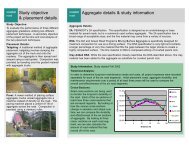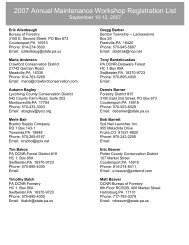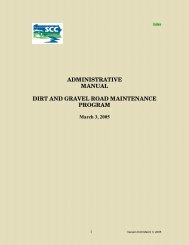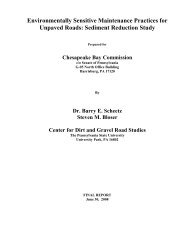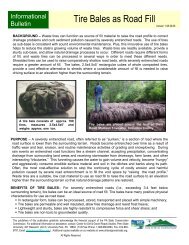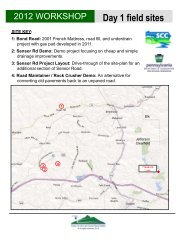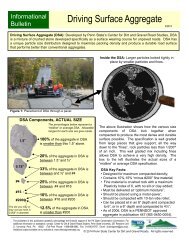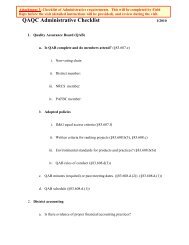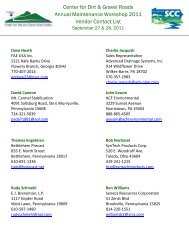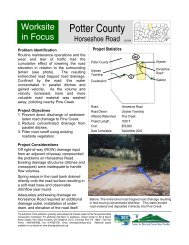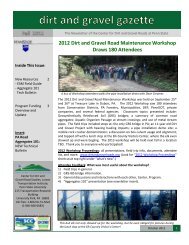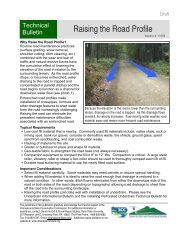DSA Issue II of CDGRS newsletter - Center for Dirt and Gravel Road ...
DSA Issue II of CDGRS newsletter - Center for Dirt and Gravel Road ...
DSA Issue II of CDGRS newsletter - Center for Dirt and Gravel Road ...
Create successful ePaper yourself
Turn your PDF publications into a flip-book with our unique Google optimized e-Paper software.
questions fromthe fieldQDo I have to use <strong>DSA</strong>on <strong>Dirt</strong> <strong>and</strong> <strong>Gravel</strong>Projects?ASurface Aggregate is notrequired on <strong>Dirt</strong> <strong>and</strong> <strong>Gravel</strong><strong>Road</strong> Program projects. IF,however, a surfaceaggregate is purchased usingProgram funds, <strong>DSA</strong> is theonly approved aggregate.Several Districts haveadopted policies <strong>of</strong> NOTpaying <strong>for</strong> <strong>DSA</strong> (or anysurface aggregate) with <strong>Dirt</strong><strong>and</strong> <strong>Gravel</strong> <strong>Road</strong> Programfunds, typically citingconsistency <strong>and</strong> cost issues.As one Northern Tier Countyput it: “We can fund twoprojects a year with <strong>DSA</strong>, or10+ projects a yearcorrecting drainage issues.”A large part <strong>of</strong> what makesthe D&G Program workeffectively is “Local Control”that allows Districts to adoptpolicies such as this that fittheir local situation.Another strategy toreduce costs is to only use<strong>DSA</strong> in shorter “streamsensitive” sections <strong>of</strong> roadwhere some run<strong>of</strong>f to thestream is unavoidable.Remember: the <strong>Dirt</strong> <strong>and</strong><strong>Gravel</strong> <strong>Road</strong> Program is awater quality program, notjust a road surfacingprogram.Have a question? Submit it todirt<strong>and</strong>gravel@psu.edu<strong>DSA</strong> Quality ControlOwed in large part to the aggregate shortages described on the front page, the <strong>Center</strong>has seen the Quality <strong>of</strong> <strong>DSA</strong> from some suppliers suffer over the last two years (even fromlarge suppliers with <strong>DSA</strong> experience). Many times <strong>Center</strong> staff have been called out to a jobbecause “the <strong>DSA</strong> did not work.” In almost every case, the failure has been due to eithersubst<strong>and</strong>ard <strong>DSA</strong>, the passing <strong>of</strong>f <strong>of</strong> another product as <strong>DSA</strong>, or improper base preparationor aggregate placement. An ounce <strong>of</strong> prevention is worth a pound <strong>of</strong> cure. To insureaggregate quality, the <strong>Center</strong> continues to recommend that you visit <strong>and</strong> work with thequarry prior to aggregate placement. <strong>Center</strong> staff are available to accompany you to visitthe Quarry be<strong>for</strong>e the aggregate is sent to the job. It is a lot easier to deal with potentialproblems at the quarry be<strong>for</strong>e the stone reaches your jobsite.<strong>DSA</strong> Testing OptionsConsider using an independent lab to test the aggregate to insure it will per<strong>for</strong>m asexpected. When using an independent laboratory <strong>for</strong> analyzing <strong>DSA</strong>, there are tworecommended tests:1) Hydrometer test & Plasticity Index, (~$200). This test will determine the type <strong>of</strong> material(clay vs. crushed rock) that makes up the aggregate fines.• The Sieve Analysis with Wash, shows the percentages <strong>of</strong> the material passing thefive sieve sizes. These gradations should fall within the corresponding specificationrange <strong>for</strong> each sieve size. (While sieve analysis can be done alone, it is already done aspart <strong>of</strong> the Hydrometer test)2) The St<strong>and</strong>ard Proctor Analysis, (~$145) determines the optimum moisture <strong>and</strong>maximum density <strong>for</strong> the specific material. On-site compaction testing can be conducted bya lab technician, (~$50/hour). In<strong>for</strong>mation obtained from the Proctor analysis is used tocalibrate a Nuclear Density Meter, which uses a probe inserted through the <strong>DSA</strong> just afterplacement. Moisture content <strong>of</strong> the material is measured, along with maximum densityafter compaction. Maximum densities <strong>of</strong> 95% or better (<strong>of</strong> theoretical maximum densitydetermined during proctor test) should be realized on the aggregate in the field.The cost <strong>of</strong> the <strong>DSA</strong> testing above can be included as part <strong>of</strong> Program grant applicationsunder "Project Expenditures." When you are spending $10,000 to $40,000 on <strong>DSA</strong>, the ~$350 -$500 in up-front testing seems like a bargain compared to remediating an inferioraggregate job.What Should You Do to Insure Quality <strong>DSA</strong>?• Visit the quarry. Talk with the quarry early (2 weeks be<strong>for</strong>e job) to make sure theyunderst<strong>and</strong> <strong>DSA</strong>. Inspect the pile <strong>and</strong> look <strong>for</strong> problems be<strong>for</strong>e your job begins.• Spend the money <strong>for</strong> <strong>DSA</strong> testing described above. It is an allowable contract expense inthe Program <strong>and</strong> could save you money <strong>and</strong> headaches in the future.• If you need help with a <strong>DSA</strong> placement, or help with the recommended testing above,contact the <strong>Center</strong> <strong>for</strong> assistance. (give us as much lead time as possible)• Get a current “<strong>DSA</strong> Certification” from the Quarry with the first delivered load.• Take r<strong>and</strong>om aggregate samples during <strong>DSA</strong> placement. These samples may provevaluable if per<strong>for</strong>mance issues arise on the road in the future.2 August 2011-Steve Bloser (<strong>CDGRS</strong>)



